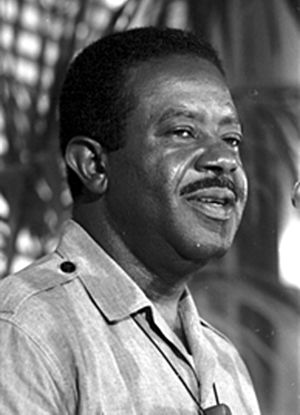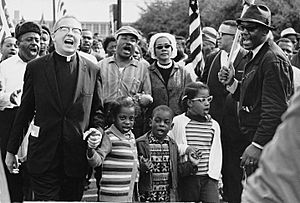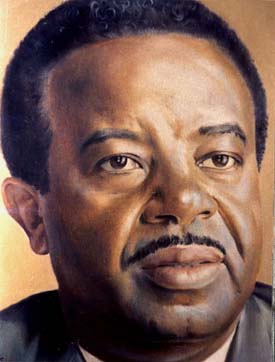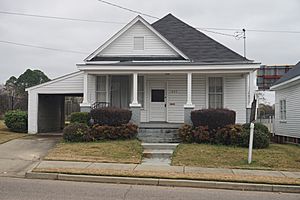Ralph Abernathy facts for kids
Quick facts for kids
Ralph Abernathy
|
|
|---|---|

Abernathy in 1968
|
|
| 2nd President of the Southern Christian Leadership Conference | |
| In office 1968–1977 |
|
| Preceded by | Martin Luther King Jr. |
| Succeeded by | Joseph Lowery |
| Personal details | |
| Born |
David Abernathy
March 11, 1926 Linden, Alabama, U.S. |
| Died | April 17, 1990 (aged 64) Atlanta, Georgia, U.S. |
| Political party | Democratic |
| Spouse | Juanita Jones Abernathy |
| Children | 5, including Ralph III and Donzaleigh |
| Occupation | Clergyman, activist |
| Known for | Civil rights movement Peace movement Closest friend and mentor of Martin Luther King Jr. |
| Military service | |
| Allegiance | United States |
| Branch/service | United States Army |
| Rank | Platoon Sergeant |
| Battles/wars | World War II |
Ralph David Abernathy Sr. (born March 11, 1926 – died April 17, 1990) was an American civil rights leader and Baptist minister. He was a close friend and helper of Martin Luther King Jr. Together, they worked to create the Montgomery Improvement Association. This group led the important Montgomery Bus Boycott. He also helped start the Southern Christian Leadership Conference (SCLC).
After King was assassinated in 1968, Abernathy became the president of the SCLC. He led the Poor People's Campaign in Washington, D.C.. This campaign helped people who were struggling. He also worked for peace and helped solve problems, like during the Wounded Knee Occupation in 1973. He wrote a book about his life and the civil rights movement called And the Walls Came Tumbling Down. Ralph Abernathy died in 1990.
Contents
Early Life and Education
Ralph Abernathy was born on March 11, 1926, in Linden, Alabama. He was the 10th of 12 children. His family had a large farm. His father was the first African-American to vote and serve on a jury in their county.
Ralph went to Linden Academy, a Baptist school. Even as a student, he led protests to make things better for his classmates. During World War II, he joined the United States Army. He became a platoon sergeant before leaving the army.
After the war, he used his G.I. Bill benefits to attend Alabama State University. He became president of the student council. He even led a hunger strike to get better food on campus! Ralph felt called to be a minister from a young age. He became a Baptist minister in 1948. He graduated with a degree in mathematics in 1950. That summer, he became the first Black man to host a radio show in Montgomery, Alabama. In 1951, he earned a master's degree in sociology from Atlanta University.
In 1951, he started working as the dean of men at Alabama State University. Later that year, he became the main pastor at the First Baptist Church in Montgomery. This was the biggest Black church in the city. He stayed there for ten years.
On August 31, 1952, he married Juanita Odessa Jones. They had five children together. In 1954, Abernathy met Martin Luther King Jr.. King was a new pastor then. Abernathy became King's mentor and they became very close friends.
Joining the Civil Rights Movement
The Montgomery Bus Boycott
On December 1, 1955, Rosa Parks was arrested for refusing to give up her bus seat to a white man. Abernathy, who was part of the NAACP, worked with King. They created the Montgomery Improvement Association (MIA). This group organized the Montgomery Bus Boycott.
Abernathy and Jo Ann Robinson handed out flyers. They asked Black citizens in Montgomery to stop riding the buses. The boycott lasted 381 days. It gained national attention. In December 1956, the U.S. Supreme Court ruled that bus segregation was against the law. The boycott ended, and it was a big success against the segregation laws.
Working with Martin Luther King Jr.
After the boycott, Abernathy's home and church were bombed. His family barely escaped, but they were safe. Other churches and homes were also bombed. This happened while King, Abernathy, and other Black leaders were meeting in Atlanta.

In January 1957, the Southern Leaders Conference was formed. In February, they changed their name to the Southern Leadership Conference. King was president, and Abernathy was the financial secretary-treasurer. In August 1957, they changed the name one last time to the Southern Christian Leadership Conference (SCLC). They decided to help Black people register to vote across the South.
In May 1961, the Freedom Riders came to Montgomery. They were protesting segregated buses. Many riders were beaten by a white mob. Abernathy and King held an event at Abernathy's church to support them. Over 1,500 people came. A mob of white segregationists surrounded the church. King called the Attorney General Robert F. Kennedy for help. U.S. Marshals were sent, but there weren't enough. The mob threw rocks and bricks. More marshals arrived. The next morning, the Governor of Alabama sent the Alabama National Guard, and the mob finally left.
After the Freedom Riders' success, King asked Abernathy to become a pastor in Atlanta. Abernathy moved his family and became pastor of West Hunter Street Baptist Church in 1962.
King and Abernathy worked together on many nonviolent movements. They were in Montgomery, Birmingham, Selma, and Memphis. They traveled together and were jailed 17 times for their activism.
During Martin Luther King Jr.'s Assassination
On April 3, 1968, Abernathy introduced King before his last speech. King said that Abernathy was his "best friend that I have in the world."
The next day, April 4, 1968, Abernathy was with King at the Lorraine Motel in Memphis, Tennessee. King was shot while standing on the balcony. Abernathy ran out and held King. He went with King to the hospital. King died at 7:05 p.m. at age 39.
Leading the SCLC
Before King's death, Abernathy was the SCLC's financial secretary and vice president. After King died, Abernathy became the SCLC president. One of his first tasks was to lead a march for striking sanitation workers in Memphis. King and Abernathy had planned this march together.
The Poor People's Campaign
In May 1968, Abernathy led the Poor People's Campaign in Washington, D.C. This campaign aimed to bring attention to poverty in America.
Speaking Out at NASA
On July 15, 1969, the day before the Apollo 11 moon launch, Abernathy went to Cape Kennedy. He brought hundreds of people from the Poor People's Campaign. They protested that the government was spending too much on space. They felt the money should be used to help poor Americans.
He met with Thomas O. Paine, the head of NASA. Abernathy told him that space travel was not as important as feeding the hungry and housing the homeless. Paine said that solving human problems was much harder than space exploration. Abernathy admitted he was impressed by the space achievement. But he insisted that if America could go to the moon, it could also help its poor citizens.
Later in 1969, Abernathy also helped hospital workers in Charleston, South Carolina. His efforts led to better pay and working conditions for thousands of workers.
Helping at Wounded Knee
In 1973, Abernathy helped make peace at the Wounded Knee Occupation. This was a standoff between the Federal Bureau of Investigation and Native American leaders.
Abernathy was president of the SCLC for nine years after King's death. The organization faced challenges after King was gone. In 1977, Abernathy stepped down as president. He was given the title "president emeritus."
Later Life and Legacy
In 1971, Abernathy spoke at the United Nations about world peace. He was also on the board of the Martin Luther King Jr. Center. In 1977, he ran for a seat in the U.S. House of Representatives in Georgia, but he did not win.
He started a group called the Foundation for Economic Enterprises Development (FEED). This group helped unemployed Black people get training and jobs.
In 1982, Abernathy spoke to the U.S. Congress. He supported extending the Voting Rights Act. This law helps protect the right to vote for all Americans.
His Autobiography
In 1989, Abernathy published his autobiography, And the Walls Came Tumbling Down. It told the story of his close friendship with King and their work in the civil rights movement.
Death
Ralph Abernathy died on April 17, 1990, at age 64. He died from blood clots that went to his heart and lungs. After he died, George H. W. Bush, who was then the President of the United States, said that Abernathy was "a great leader in the struggle for civil rights for all Americans."
He is buried in Lincoln Cemetery in Atlanta. On his tombstone, it simply says: "I TRIED."
Tributes and Portrayals
Ralph Abernathy received over 300 awards during his life. He also received five honorary doctoral degrees from different colleges.
- Ralph D. Abernathy Hall at Alabama State University is named after him.
- Interstate 20 Ralph David Abernathy Freeway, Abernathy Road, and Ralph David Abernathy Boulevard in Atlanta are named in his honor.
Actors have played Ralph Abernathy in several films and TV shows:
- Ernie Lee Banks in the 1978 miniseries King.
- Terrence Howard in the 2001 HBO film Boycott (2001 film).
- Colman Domingo in the 2014 film Selma.
- Dohn Norwood in the 2016 film All the Way.
Works
- Abernathy, Ralph; And the Walls Came Tumbling Down (1989), ISBN: 9781569762790
- Abernathy, Ralph; The Natural History of A Social Movement: The Montgomery Improvement Association (thesis)
See Also
 In Spanish: Ralph David Abernathy para niños
In Spanish: Ralph David Abernathy para niños



